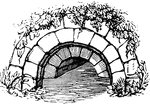Clipart tagged: ‘Sewers’

Cloaca
"A sewer, a drain. Rome was intersected by numerous sewers, some of which were of an immense size: the…

Collection of Sewer Cross-Sections
"A conduit or canal constructed, especially in a town or city, to carry off superfluous, water, soil,…